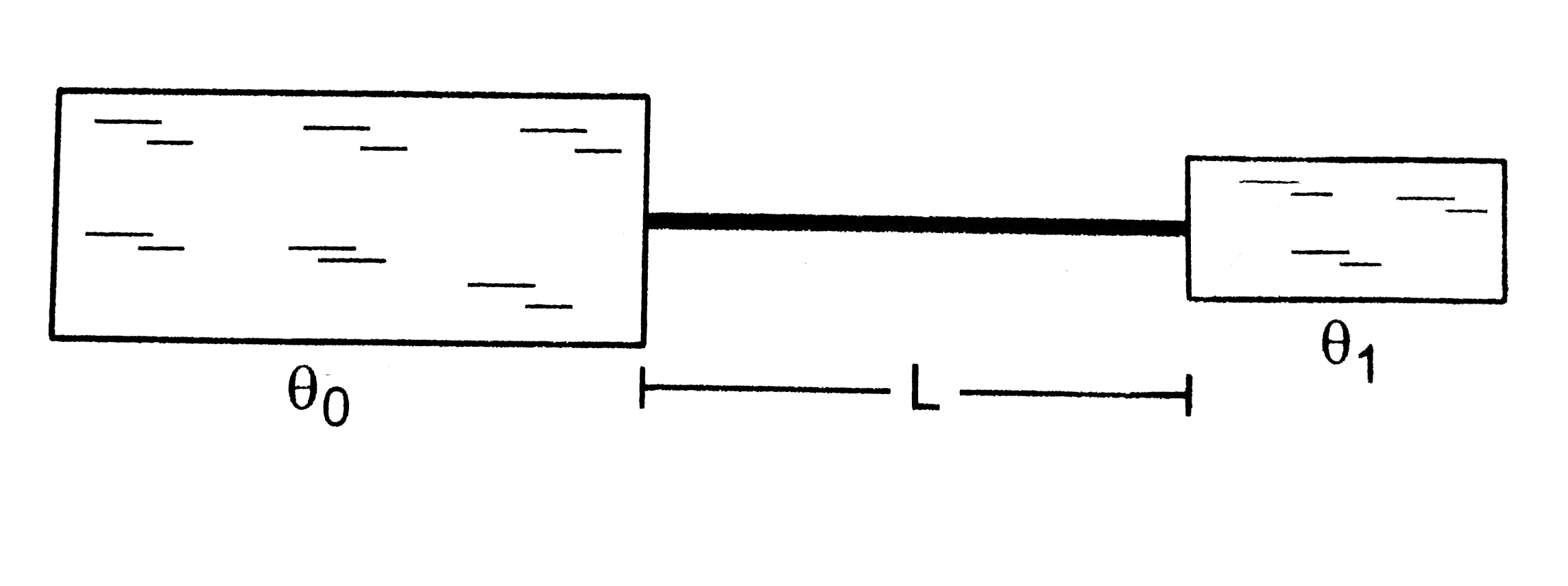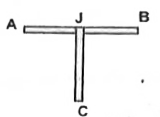Figure shown two adiabatic vessels, each containing a mass m of water at different temperature. The ends of a metal rod of length L, area of cross section. A and thermal conductivity K, are inserted in the water as shown in the figure. Find the time taken for the difference between the temperature in the vessels to become half of the original value. The specific heat capacity of water is s. Neglect the heat capacity of the rod and the container and any loss of heat top the atmosphere.

The correct Answer is:A, B
(Qt)=KA(T1−T2)Lms
Rise∈temperature∈T2=KA(T1−T2)Lms
Fall in temperature om
T1=KA(T1−T2)Lms
F∈altempertureT1=T1−KA(T1−T2)Lms
F∈altemperatureT2=T2+KA(T1−T2)Lms
⇒dTdt=2KA(T1−T2)Lms
⇒InT1−T22(T1−T2)=2KALmst
In2=2KALmst
t=Lms2KAIn2.

Topper's Solved these Questions
- BOOK - HC VERMACHAPTER - HEAT TRANSFEREXERCISE - EXERCIESE1videos
HEAT TRANSFER
- BOOK - HC VERMACHAPTER - HEAT TRANSFEREXERCISE - Objective 26videos
HEAT TRANSFER
- BOOK - HC VERMACHAPTER - HEAT AND TEMPERATUREEXERCISE - Exercise4videos
HEAT AND TEMPERATURE
- BOOK - HC VERMACHAPTER - INTRODUCTION TO PHYSICSEXERCISE - Exercises19videos
INTRODUCTION TO PHYSICS
Similar Questions
Two bodies each of mass m, having specific heats s, are connected by ametal rod of negligible heat capacity of length l, area of cross section A and thermal conductivity k. Initially both bodies are at different temperatures, find the time taken for the temperature difference between the two bodies to become half of the. initial value.
View SolutionFigure shows a large tank of water at a constant temperature θ0 . and a small vessel containinng a mass m of water at an initial temperature θ(<θ0.Amηlrodof≤n>hL,areaofcrosssectionAandthermalconductivityKco∩ectthetwovessels.F∈dthetimetakenforthetemperatureofthewater∈thesmal≤rvessel→becometheta_(2)(theta_(1)lttheta_(2)lttheta_(0)) . Specific heat capacity of water is s and all other heat capacities are negligible.
 View Solution
View Solution
Knowledge Check
- Question 1 - Select One
Two adiabatic vessels, each containing the same mass m of water but at different temperatures, are connected by a rod of length L, cross-section A, and thermal conductivity K. the ends of the rod are inserted into the vessels, while the rest of the rod is insulated so that .there is negligible loss of heat into the atmosphere. The specific heat capacity of water is s, while that of the rod is negligible. The temperature difference between the two vessels reduces to l/e of its original value after a time, δt. The thermal conductivity (K) of the rod may be expressed by:
AmsLAδtBemsLAδtCmsL2eAδtDmsL2Aδt - Question 2 - Select One
A metal rod of area of cross section A has length L and coefficient of thermal conductivity K the thermal resistance of the rod is .
ALKABKLLCKALDAKL - Question 3 - Select One
Two bars of same length and same cross-sectional area but of different thermal conductivites K1 and K2 are joined end to end as shown in the figure. One end of the compound bar it is at temperature T1 and the opposite end at temperature T2 (whereT1>T2). The temperature of the junction is
 AK1T1+K2T2K1+K2BK1T2+K2T1K1+K2CK1(T1+T2)K1+K2DK2T1+T2K1
AK1T1+K2T2K1+K2BK1T2+K2T1K1+K2CK1(T1+T2)K1+K2DK2T1+T2K1
" A metal rod of area of cross section A has length L and coefficient of thermal conductivity K The thermal resistance of the rod is "
View SolutionThree rods of same material and of equal cross sectional area and length have been connected together as shown in the figure. The temperature of the junction of the rods approximately is
View SolutionThree rods of equal length, area of cross section and thermal conductivity are connected as shown in the figure.

There is no heat loss through lateral surface of the rods and temperature of ends are TA=100∘C,TB=70∘C and TC=50∘C. Find the temperature of junction.View SolutionFigure-4.13 shows a water tank at a constant temperature. T0 and a small bodyof mass m, and specific heat S at a temperature T1 . Given that T1<T0. A metal rod of length L, cross-sectional area A whose thermal conductivity is K is placed between the tank and the body to connect than. Find the temperature of body as a function of time. Given that the heat capacity of rod is negligible.
 View Solution
View SolutionA rod is heated at one end as shown in figure. In steady state temperature of different sections becomes constant but not same. Why so?
 . View Solution
. View Solution

